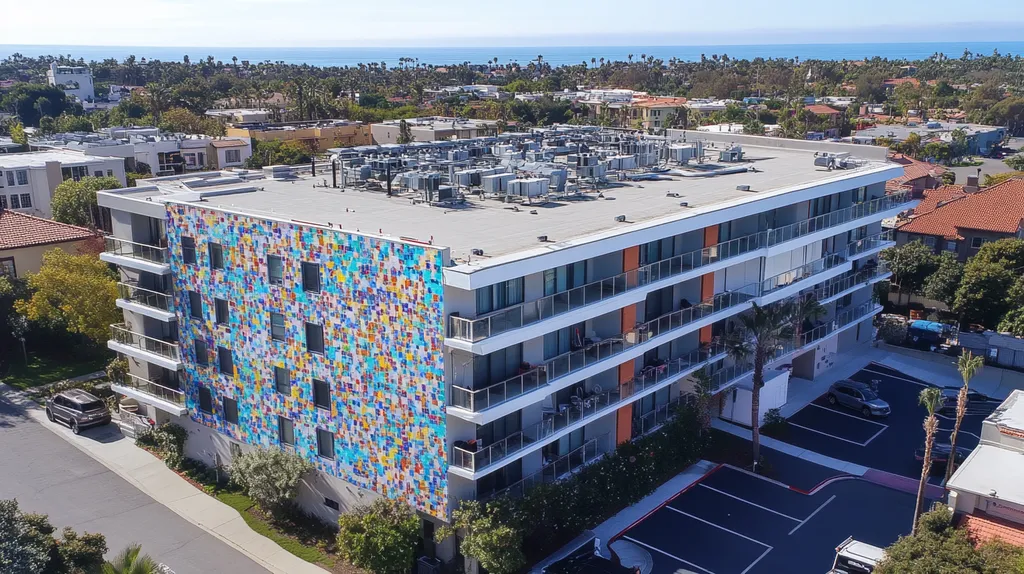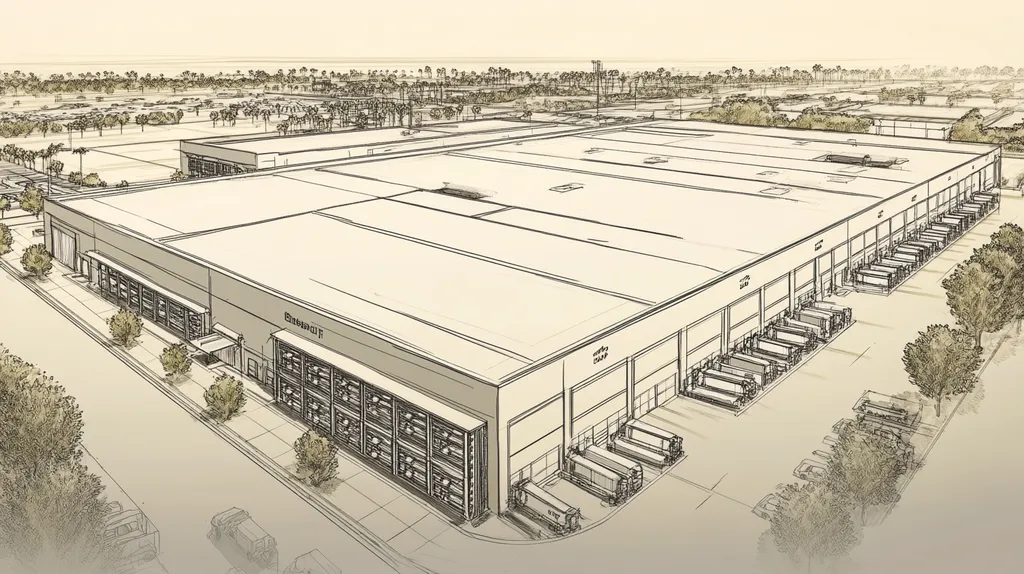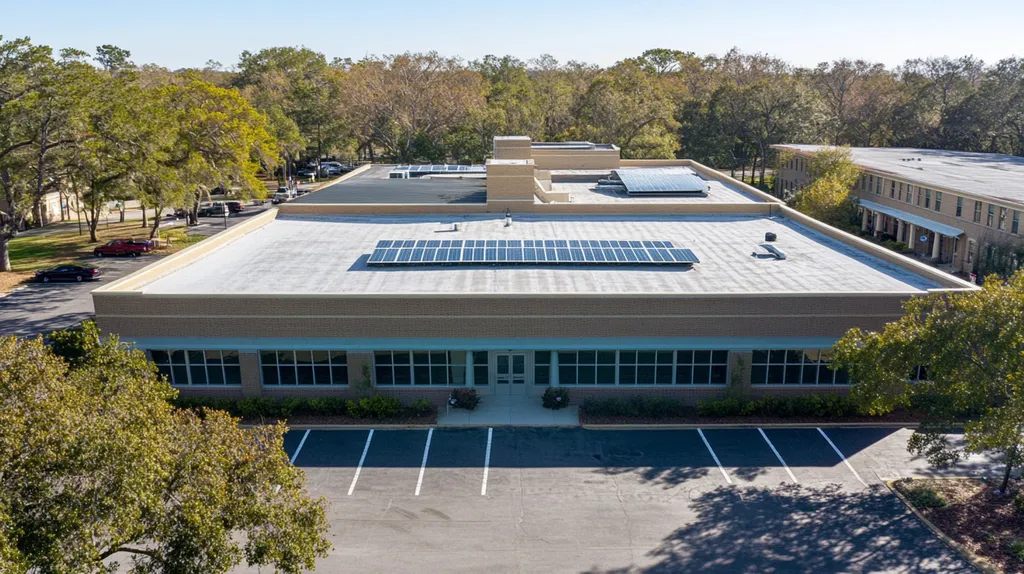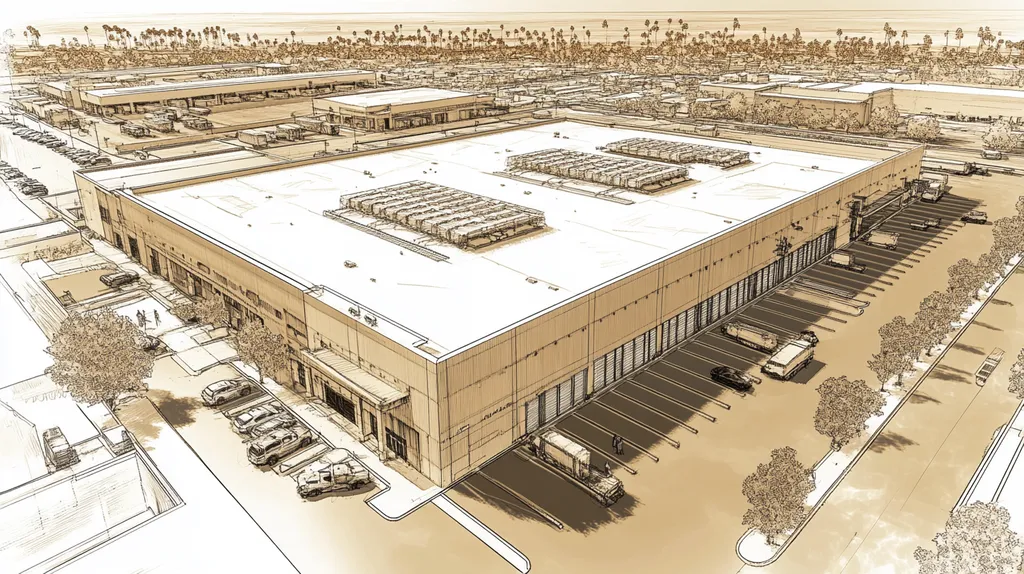In the high-stakes world of industrial roofing, a simple coating decision can mean the difference between energy efficiency and skyrocketing utility bills. Research shows that properly selected and applied roof coatings can reduce cooling costs by up to 30%, yet misconceptions continue to cost facility owners millions in wasted energy spending.
From reflective coating limitations to emerging ceramic particle technologies, understanding the real impact of coatings on thermal performance has never been more critical for the bottom line.
This comprehensive guide separates facts from fiction, exploring how coatings truly affect HVAC systems, indoor temperatures, and long-term building efficiency – empowering facility managers to make informed decisions that deliver measurable results.
SECTION 1: COMMON MISCONCEPTIONS
The thermal efficiency of industrial roofs is a game-changer when it comes to managing energy costs and boosting overall building performance. Surprisingly, many commercial property owners cling to misconceptions about coatings and their true impact on thermal performance. Research has demonstrated that implementing the right roofing coating can slash energy costs by as much as 30%! Clarifying these misconceptions is crucial for making smart roofing decisions that genuinely enhance thermal efficiency.
Reflective Coatings are Always Effective
Many facility managers hold the belief that applying a reflective coating is a surefire way to improve thermal performance. While these coatings can indeed lower heat absorption in certain climates, their effectiveness is influenced by factors such as coating quality, geographical location, and even the roof’s angle.
In cooler or temperate regions, reflective coatings may not yield the expected benefits and could even exacerbate heat loss during the winter months. Over time, their effectiveness can diminish due to environmental stressors like dirt buildup, UV exposure, and moisture.
Moreover, not all reflective coatings boast the same properties when it comes to solar reflectance and thermal emittance. Choosing a coating tailored to a facility’s specific environmental conditions is essential in unlocking maximum energy savings.
To avoid costly errors, conducting a thorough assessment of thermal performance and opting for coatings supported by reliable data is critical. A deep understanding of a facility’s unique conditions can make a significant difference in the impact of reflective coatings.
All Coatings Provide Equal Insulation
Another widespread misconception is that all roof coatings possess similar insulation capabilities. In reality, the thermal performance of coatings varies widely. While some coatings enhance insulation, others predominantly reflect solar radiation.
For instance, liquid-applied coatings like elastomeric options can offer enhanced insulation due to their thickness and ability to adapt to temperature changes. In contrast, traditional coatings may not provide this benefit and could potentially expose the underlying materials to temperature variations.
This understanding is vital for facility managers aiming to maximize energy efficiency. Selecting the wrong type of coating can lead to increased operational costs and even premature roof failures. Recognizing the distinct insulation properties of various coatings empowers informed decision-making.
Ultimately, aligning coatings with insulation objectives involves evaluating the specific thermal needs of a facility. This assessment can dramatically improve the long-term performance of a roof, highlighting the importance of well-informed coating choices.
Coatings Do Not Require Maintenance
Many involved in facility management mistakenly view coatings as a “set it and forget it” solution. However, neglecting regular maintenance can undermine the effectiveness of coatings and lead to greater roof issues over time. As coatings wear down, their thermal performance may decline, increasing susceptibility to leaks.
Routine inspections and maintenance are crucial for ensuring that coatings maintain their performance. Elements such as local weather conditions, debris, and biological growth can deteriorate a coating’s integrity, diminishing its thermal benefits.
Conducting regular maintenance helps catch early signs of wear, enabling timely repairs. Addressing these issues quickly can prolong the life of both the coating and the overall roofing system.
Facility managers should prioritize a robust maintenance schedule that includes periodic assessments to keep roofs in peak condition. By recognizing the need for ongoing care, property owners can safeguard their investments while enhancing energy efficiency.
SECTION 2: PRACTICAL IMPLICATIONS
The thermal performance of industrial roofs is not just a technical detail; it can make or break operational efficiency and cost management. Coatings designed to reflect sunlight can dramatically lower roof temperatures, enhancing HVAC performance in the process. According to the U.S. Department of Energy, reflective roofing can reduce roof surface temperatures by up to 60 degrees Fahrenheit. This section delves into how these coatings impact HVAC systems, indoor climate control, and overall energy consumption in commercial properties.
Impact on HVAC System Performance
A well-coated roof serves as a powerhouse for HVAC system efficiency by lightening the cooling load. With roofs that absorb less heat, HVAC systems have a much easier job of maintaining comfortable indoor temperatures. This not only extends the life of the equipment but also cuts down on maintenance needs.
Facilities equipped with reflective coatings can see cooling energy use drop by as much as 30%. Less demand on HVAC systems means fewer breakdowns and repairs, streamlining resources and budgets.
In contrast, roofs lacking proper coatings or routine maintenance can inflate repair costs. Facility managers should view roofing coatings as strategic investments that bolster HVAC reliability.
Ultimately, the performance boosts from utilizing advanced coatings can lead to impressive savings, highlighting the critical nature of making informed roofing choices for long-term operational success.
Effects on Indoor Temperature Regulation
The use of reflective coatings plays a vital role in regulating indoor temperatures. By minimizing heat transfer from the roof, these coatings help create a more stable indoor climate. This consistency is essential for protecting sensitive equipment and ensuring employee comfort.
Buildings equipped with effective thermal coatings can experience temperature fluctuations that decrease by over 5 degrees. This is particularly advantageous in manufacturing settings, where extreme temperatures can compromise product quality.
Furthermore, a stable indoor environment boosts worker productivity. Research shows that comfortable workspaces enhance focus and reduce absenteeism, ultimately impacting business performance.
Thus, choosing the right roof coatings must be seen as a crucial element in fostering an optimal indoor atmosphere for both operational efficiency and workforce well-being.
Influence on Building Energy Consumption
The energy consumption profile of commercial buildings is profoundly shaped by the performance of their roofs. Thermally efficient coatings can lead to significant reductions in both cooling and heating energy demands. By reflecting solar energy, these coatings also help alleviate the urban heat island effect, lessening the energy burden on the surrounding infrastructure.
On average, buildings with reflective roof coatings consume roughly 20% less energy than those that don’t. This energy reduction not only translates to lower utility costs but also shrinks the building’s carbon footprint.
Moreover, energy-efficient buildings often attract more tenants and buyers, enhancing property value. Thus, investing in quality roof coatings is a proactive step toward sustainability and effective operational cost management.
Overall, the undeniable link between roofing coatings and energy consumption underscores the need for informed decision-making that aligns with both financial and environmental goals.
SECTION 3: COST OF MISINFORMATION
Misinformation about industrial roofing coatings can pose a significant financial risk for property owners and facility managers. Misguided beliefs can lead to higher energy costs, reduced lifespans for both roofs and HVAC systems, and missed chances for impactful energy savings. Understanding the truth about coatings is essential to preventing unnecessary financial strain and maximizing operational efficiency.
Increased Energy Costs Over Time
Misunderstanding the role of roofing coatings can lead to inflated energy expenses. A quality reflective coating can substantially lower surface temperatures, easing the burden on HVAC systems during the warm months. Without this advantage, buildings may incur cooling costs that are 10-30% higher than necessary.
Research indicates that uncoated roofs absorb significant heat, forcing air conditioning units to overexert themselves. This inefficiency causes energy costs to creep up over time, negatively impacting profitability. Property owners sticking to outdated roofing methods might find themselves facing exorbitant electricity bills, eating into their bottom line.
Moreover, neglecting to invest in effective coating technologies can result in sky-high operating costs. Facilities without energy-efficient coatings might struggle in cost management, leading to inflated utility bills that could have been avoided. Misunderstandings around coating capabilities lead to significant financial repercussions.
Ultimately, clarity on thermal performance empowers building owners to make informed choices, resulting in substantial energy savings. Misconceptions surrounding roofing coatings create avoidable financial burdens that can accumulate over the years.
Reduced Roof and HVAC Lifespan
Failing to recognize the thermal benefits of coatings can drastically cut the lifespans of roofs and HVAC systems. When applied correctly, reflective coatings shield roofing materials and mitigate wear from temperature extremes. Without such protection, roofs face damaging heat absorption that leads to quicker deterioration.
This excess heat not only increases the aging process of roofing membranes but also forces HVAC units to work harder, ultimately shortening their operational lifespan. The financial implications of having to replace roofs and HVAC systems can be staggering.
Industry data reveals that improperly maintained roofs can fail up to 30% sooner than those treated with appropriate coatings. This hidden cost reflects both the direct expenses of replacement and the lost revenue due to downtime during those replacements. Recognizing the impact of coatings is vital for extending the life of key building components.
Investing in effective thermal coatings can significantly prolong the usability of roofs and HVAC equipment. Choosing the correct coating technology enables buildings to operate efficiently for years, safeguarding owners from costly replacements down the road.
Missed Opportunities for Energy Savings
Misunderstandings surrounding roofing coatings can result in the loss of valuable energy savings opportunities. Many property managers might be unaware of available rebate programs and tax incentives linked to energy-saving enhancements. This lack of awareness can lead to falling short of budgetary objectives.
For example, buildings equipped with reflective coatings are often eligible for substantial energy rebates from utility providers. However, without proper knowledge, owners may miss out on these savings programs. Ignoring these immediate savings can hinder overall financial performance.
Additionally, upgrading to a superior coating system can improve a building’s Energy Star rating. Higher ratings not only signify operational efficiency but can also significantly elevate property value. Misconceptions about coatings can limit owners’ awareness of potential benefits, creating hesitance to make necessary investments.
A lack of understanding regarding the advantages of updated coatings not only stifles energy efficiency but can also lead to missed financial gains. By educating themselves about the impact of coatings, property owners can strategically position their buildings for long-term financial rewards and enhanced operational performance.
SECTION 4: REALITY CHECK
When it comes to energy efficiency, roof coatings are the unsung heroes of industrial roofing. The United States Department of Energy highlights a staggering fact: roofs can absorb up to 90% of solar energy, which dramatically raises a building’s energy consumption. It’s essential to comprehend how coatings impact thermal performance; property owners running on misconceptions risk wasting both money and resources. This section will explore the inner workings of coatings, pinpoint the limitations of traditional reflective options, and showcase the cutting-edge technologies transforming roof coatings today.
How Coatings Actually Work
Coatings function as a protective layer, reflecting harmful UV rays and reducing heat absorption in roofs. By applying a reflective coating, buildings can significantly lower their roof temperatures, which helps balance thermal expansion and contraction. This process is crucial for ensuring that the structural integrity of the roof is maintained for the long haul.
The effectiveness of a coating is assessed using the Solar Reflectance Index (SRI), a measurement that determines how well a roof reflects solar energy. A higher SRI indicates better performance in mitigating heat buildup, so property owners should prioritize coatings with high reflectivity to maximize their energy savings.
But the benefits of coatings extend beyond just heat reflection. They also act as vital shields against weather-related damage, sealing up minor cracks and preventing water leaks which can contribute to a longer roof lifespan. A well-chosen coating provides dual protection: it insulates against heat while guarding against environmental wear and tear.
Grasping these dynamics enables facility managers to make well-informed decisions about maintenance and energy efficiency strategies, paving the way for enhanced building performance.
Limitations of Traditional Reflective Coatings
However, traditional reflective coatings do come with their limitations. Over time, exposure to elements like UV rays and physical wear can cause these coatings to degrade, losing their reflective capabilities. As a result, energy costs may rise when roofs become less efficient at deflecting heat.
Moreover, many of these coatings only tackle surface temperature issues without addressing the overall insulation of the building. A roof with an effective reflective coating but poor insulation can still suffer from heat gain, undermining the coating’s benefits.
Aesthetic concerns also often limit the choice of colors in traditional coatings. While lighter options, like white or light gray, are popular for their reflectivity, they might not suit a building’s overall design. This can lead to compromises that don’t fully deliver on energy savings.
Understanding these constraints is critical; property owners should not rely solely on traditional reflective coatings without exploring more comprehensive solutions that fully weigh all factors.
Advanced Technologies in Roof Coatings
The roofing industry is currently experiencing a revolution with the advent of advanced technologies that significantly boost thermal performance. The latest innovations include coatings that seamlessly blend reflective properties with enhanced insulation features. These hybrid coatings are designed to simultaneously combat heat reflection while adding thermal resistance, paving the way for superior energy efficiency.
Moreover, the introduction of nanotechnology is transforming the coatings landscape, leading to products that are more durable and longer-lasting. These modern coatings resist environmental degradation far better than traditional options, ensuring their effectiveness remains intact over time.
Some cutting-edge coatings even come equipped with self-cleaning properties, which can dramatically cut down maintenance costs while ensuring that reflectivity is preserved. By harnessing multiple technological advancements, these coatings present a more robust solution for thermal management in industrial settings.
Ultimately, adopting these innovations can lead to significant energy savings and enhanced building performance, positioning property owners to achieve both environmental sustainability and budgetary goals.
SECTION 5: EVIDENCE-BASED ALTERNATIVES
The demand for energy-efficient roofing solutions has never been higher, especially as energy prices continue to climb. Traditional roofing systems may no longer meet the increasing needs of commercial properties. Enter innovative alternatives like Insulative Ceramic Particle (ICP) Technology, which promise significant improvements in thermal performance. This section will dive into the powerful benefits of ICP technology, present successful case studies of cool roof implementations, and discuss how these advancements align with energy efficiency regulations.
Benefits of Insulative Ceramic Particle (ICP) Technology
Insulative Ceramic Particle (ICP) Technology is revolutionizing thermal management for roofs by combining reflection and insulation. By embedding tiny ceramic particles, these coatings keep roofs cooler under the sun. With superior insulation capabilities, buildings can achieve stable indoor temperatures, leading to reduced energy consumption.
These coatings also minimize temperature fluctuations inside the building, fostering a comfortable environment for occupants. This stability is crucial for protecting delicate equipment and materials that can be affected by extreme temperature changes. Ultimately, property owners can enjoy lower maintenance costs and longer-lasting roofs.
Another benefit of ICP technology is its lightweight nature and ease of application, ensuring that installation is swift and minimally disruptive. Facility operations can continue unhindered while improvements in thermal performance are made. Therefore, it becomes easier for property owners to embrace energy efficiency without sacrificing business productivity.
In summary, ICP Technology not only addresses immediate thermal management challenges but also aligns seamlessly with sustainability goals, embodying the industry’s commitment to energy-efficient practices.
Case Studies of Successful Cool Roof Implementations
Across various commercial and industrial sectors, the implementation of cool roofs has demonstrated their effectiveness in enhancing thermal performance. One notable case involved a large manufacturing facility that installed a cool roof system with reflective coatings. This initiative resulted in a remarkable 20% reduction in energy consumption over the course of a year.
This decline in energy usage directly correlates with reduced cooling demands during the sweltering summer months, yielding substantial savings on utility bills. Another illustrative case featured a distribution center that adopted cool roofing materials to significantly lower rooftop temperatures, thereby improving energy efficiency.
Additionally, a university campus pursued a campus-wide retrofitting project that incorporated cool roof technology into multiple buildings. This initiative not only elevated thermal performance but also enhanced the campus’s sustainable image, inspiring eco-conscious practices among students and staff.
These case studies underline the tangible benefits of investing in cool roof systems, which can lead to improved energy efficiency while positively impacting the bottom line for property owners.
Compliance with Energy Efficiency Regulations
As energy efficiency regulations grow more stringent, property owners must adapt to remain compliant. Embracing innovative roofing solutions such as reflective coatings and advanced materials can effectively meet today’s regulatory standards.
Many states and local governments have established guidelines based on the Energy Star rating system, which promotes energy-efficient building practices. By incorporating cool roof technologies, property owners not only satisfy these regulations but also prepare for potential future standards.
Moreover, compliance often comes with financial incentives. Numerous utility companies provide rebates and tax credits for using energy-efficient materials, allowing property managers to alleviate the initial costs of new roofing systems.
A proactive stance toward compliance ensures that property owners stay competitive while contributing to broader environmental initiatives, paving the way for a more sustainable future within the industrial roofing landscape.
SECTION 6: TEST AND VERIFY
When it comes to industrial roofing, the stakes are exceptionally high. Beyond just looking good, roofs need to perform effectively to prevent expensive energy bills, structural degradation, and even potential safety hazards. Studies suggest that poorly managed thermal performance can inflate energy costs by as much as 30%. Therefore, understanding how different coating applications impact thermal efficiency is crucial for both maintenance and operational budgets. Testing and verification are the backbone of ensuring that coatings deliver genuine, measurable benefits for industrial roofs.
Methods for Measuring Thermal Performance
Measuring thermal performance is vital for objectively assessing improvements after applying coatings. One effective method is infrared thermography, which shows heat distribution across the roof surface. This technique allows property owners to identify hot spots where thermal inefficiency is significantly pronounced.
Reflective testing is another important method used to analyze a coating’s solar reflectivity. The solar reflectance index (SRI) indicates how well a coating minimizes heat buildup; a higher SRI means less heat absorption, leading to lower energy consumption inside the building.
Moreover, energy modeling software can play a pivotal role in predicting thermal performance over time. By utilizing data from actual roof installations, this technology helps forecast long-term benefits and potential energy savings, guiding prudent decisions for future investments.
Incorporating these methods creates a holistic view of a roof’s thermal efficiency, setting the stage for performance optimization.
Conducting Pre- and Post-Application Assessments
Pre-application assessments are essential for laying a strong foundation for thermal performance upgrades. These evaluations measure current insulation levels, reflectivity, and existing damage on the roof. Understanding these baseline numbers is key to making informed decisions about the appropriate coatings to use.
Post-application assessments are equally critical. By measuring thermal performance after the coating is applied, facility managers can compare outcomes with pre-application data. This side-by-side analysis confirms whether the anticipated benefits have been realized.
It is recommended to conduct follow-ups within six months of application to ensure that the new coating meets performance expectations. If results do not align with projections, timely adjustments can be made to address inefficiencies and avoid unnecessary costs.
A systematic approach to pre- and post-assessments enables property owners to verify that the coatings applied truly deliver on their promises, ensuring a solid return on investment.
Ensuring Long-Term Durability and Effectiveness
While coatings may boost initial thermal performance, their lasting effectiveness is vital for sustained success. Regular inspections and a robust maintenance routine can help identify potential deterioration, especially in high-stress areas of the roof.
Choosing UV-resistant coatings can enhance longevity by minimizing degradation due to sun exposure, thereby maintaining thermal performance over time.
Facility managers should also stay current with the latest industry standards and certifications related to coating materials. Adhering to established benchmarks ensures the chosen coatings are of high quality and durability.
Ongoing education regarding advancements in roofing technology equips property owners to make informed decisions about when coatings might need replacing or require additional applications. This proactive approach not only preserves thermal integrity but also significantly extends the lifespan of the roof.
The Bottom Line
With industrial roofing costs spiraling upward and energy prices continuing to climb, facility managers can no longer afford misconceptions about thermal coating performance.
Research shows that properly selected and maintained coatings can slash cooling costs by up to 30% while extending roof life by decades – yet studies indicate over 60% of commercial properties still rely on outdated or ineffective coating solutions.
From advanced ceramic particle technologies to rigorous testing protocols, the tools exist to dramatically improve building thermal efficiency.
The choice is clear: embrace evidence-based coating solutions that deliver measurable results, or risk falling behind in an increasingly competitive market where every percentage point of energy efficiency matters.
Tomorrow’s industrial roofing winners will be those who separate coating facts from fiction today.
FREQUENTLY ASKED QUESTIONS
Q. Do reflective coatings really work on my commercial roof?
A. Reflective coatings can indeed enhance thermal performance, but their effectiveness varies. Factors like coating quality, your location, and roof angle play a significant role. It’s essential to assess the specific conditions of your building to determine if reflective coatings will yield the desired energy savings.
Q. How do coatings impact the HVAC system for industrial roofs?
A. Coatings can significantly lighten your HVAC system’s cooling load, allowing for better temperature maintenance. By decreasing heat absorption, these coatings help your HVAC units operate more efficiently, leading to reduced energy consumption and extending the life of your equipment.
Q. Why are misconceptions about coatings a problem for industrial roofs?
A. Misconceptions can lead to increased operational costs and premature roof failures. If property managers don’t understand the true potential of coatings, they may miss opportunities for energy savings and efficient roof performance, resulting in significant financial strain over time.
Q. What should I know about the limitations of traditional coatings?
A. Traditional coatings can degrade over time due to weather exposure, losing their effectiveness. Additionally, they may only address surface temperature without improving insulation, potentially leading your industrial roof to still experience heat gain. It’s important to explore advanced options for optimal performance.
Q. How does Insulative Ceramic Particle technology help industrial roofs?
A. ICP technology combines reflection and insulation capabilities, helping roofs stay cooler under sunlight. This leads to stable indoor temperatures and reduced energy consumption, ultimately protecting sensitive equipment while also being lightweight and easy to apply, minimizing disruptions to operations.
Q. How can I measure the thermal performance of my industrial roof?
A. You can measure thermal performance using methods like infrared thermography, which reveals heat distribution, and reflective testing to assess a coating’s solar reflectance. These techniques help identify inefficiencies and inform decisions on the best coatings for your commercial roof.
Q. What maintenance do coatings require for my industrial roof?
A. Regular inspections and maintenance are vital to preserve a coating’s effectiveness. Environmental factors can deteriorate the coatings over time, so addressing wear and tear promptly will prolong both the coating and the roof’s lifespan, ensuring ongoing thermal performance and energy savings.










